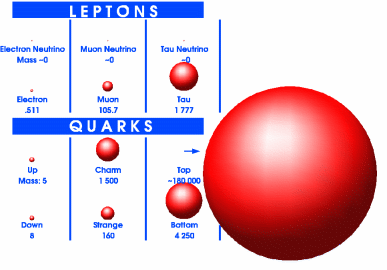|
|
Where in the World is Single Top?
''Where in the World is Carmen Sandiego?'' This is the name of a
popular interactive video game
where players become Interpol detectives and conduct a police
investigation. Particle physicists are also detectives, and though we do
not investigate crime scenes, we do investigate the fundamental
properties of matter and the underlying laws of our universe. One of the
most interesting cases for particle physicists today is the search for
the creation of single top quarks at high
energy particle colliders.
The top
quark was discovered
at the Fermilab Tevatron
Collider in 1995. It is by far the heaviest known elementary
particle observed in nature. Quarks
are one of the fundamental building blocks of matter in the universe.
They do not appear individually, but they combine to form particles
called hadrons
like the proton and neutron. Similarly, antiquarks
combine to form antiprotons and antineutrons.

Besides quarks, the other fundamental building block of
matter consists of leptons.
The most commonly known lepton is the electron, which together with
protons and neutrons form atoms and molecules, out of which everything
around us is made. These two building blocks and their interactions form
the ''standard model'' of particle physics.
The standard model
has successfully predicted the existence of top quarks and their
creation in particle-antiparticle pairs through the strong
force at the Tevatron, also known as top quark pair production.
Another prediction for the Tevatron is single top quark production or
the creation of individual top quarks without the corresponding partner.
Single top quark production has not yet been observed, but the search is
an important test of the standard model and provides a laboratory to
look for new physical forces and particles.
Unlike top quark
pair production, single top quark production occurs through the weak
force which is also responsible for the radioactive decay of
particles like the neutron. The weak force not only produces the top
quark, but it is also responsible for its decay into a bottom
quark, a lepton,
and a neutrino
which can be measured by a detector.
The Tevatron collides
protons and antiprotons with the highest energy in the world and
produces over two million collisions or events per second. From this
vast number of collisions, interesting and rare events are selected for
further study and recorded with the Dě
detector. The standard model predicts that on average, a single top
quark is produced for every 330 million collisions.
The first
step in the experimental search for single top quark production is to
select events that contain a b quark, a lepton, and a neutrino from the
330 million collisions. This reduces the number to 700 events. But life
as an experimental particle physicist isn't that easy because many other
processes look like a single top quark event. These imitators are called
background events.
At this stage, there are 50 times more
background events than expected single top quark events or signal
events. Because the background is so much larger than the expected
signal, it would take over 20 years to collect enough data to
definitively prove the existence of a signal using simple event counting
techniques. Therefore, a more advanced analysis technique is needed that
takes into account the full event information.
We use a
technique derived from a field of machine learning called
classification. We use a tool called a neural network to do this. This
technique comes from models developed in the early 1960's where
scientists tried to mimic the function of the human brain by emulating
neurons. In our analysis, a neuron corresponds to a physical property of
the event. Many neurons are combined to form a neural network. Simulated
single top quark signal as well as background events are presented to
the network such that the neurons learn the difference between the two.
After the network has been trained in this way, it is used to classify
the 600 interesting events as signal or pesky background.

Selected
signal-like event as seen in the detector.
We use the
result of this classification to look for evidence of single top quark
production. We have searched through 10,000 billion collisions recorded
with the Dě detector, corresponding to over 3 Terabytes of data. We have
reached a sensitivity to single top quark production that is a factor
two better than any previous search. We have not found significant
evidence for single top quark production in our data. While this is not
quite enough sensitivity to confirm or refute the standard model, we are
nevertheless exploring a region sensitive to models of new physics
beyond the standard model.
The story does not end here. The Dě
detector has four times more data available for analysis. We are also
improving the understanding of our detector and incorporating new
analysis techniques. So, as a colleague of ours stated in a seminar,
''Where in the World is Single Top?''
The full article can be
found here. A summary
for high energy physicists can be found here.
For more information on this analysis, please contact the primary
authors: Aran Garcia-Bellido, Leonard Christofek, Ann Heinson,
Supriya Jain, and Reinhard Schwienhorst.
| |